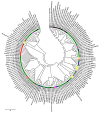Isolation and Characterization of Root-Associated Bacterial Endophytes and Their Biocontrol Potential against Major Fungal Phytopathogens of Rice (Oryza sativa L.)
- PMID: 32121142
- PMCID: PMC7157602
- DOI: 10.3390/pathogens9030172
Isolation and Characterization of Root-Associated Bacterial Endophytes and Their Biocontrol Potential against Major Fungal Phytopathogens of Rice (Oryza sativa L.)
Abstract
Rice (Oryza sativa L.) is a major cereal food crop worldwide, and its growth and yield are affected by several fungal phytopathogens, including Magnaporthe oryzae, Fusarium graminearum, F. moniliforme, and Rhizoctonia solani. In the present study, we have isolated and characterized root-associated bacterial endophytes that have antifungal activities against rice fungal phytopathogens. A total of 122 root-associated bacterial endophytes, belonging to six genera (Bacillus, Fictibacillus, Lysinibacillus, Paenibacillus, Cupriavidus, and Microbacterium) and 22 species were isolated from three rice cultivars. Furthermore, the 16S rRNA sequence-based phylogeny results revealed that Bacillus was the most dominant bacterial genera, and that there were 15 different species among the isolates. Moreover, 71 root-associated endophytes showed antagonistic effects against four major fungal phytopathogens, including M. oryzae, F. graminearum, F. moniliforme, and R. solani. Additionally, the biochemical, physiological, and PCR amplification results of the antibiotic-related genes further supported the endophytes as potential biocontrolling agents against the rice fungal pathogens. Consequently, the findings in this study suggested that the isolated bacterial endophytes might have beneficial roles in rice defense responses, including several bioactive compound syntheses. The outcomes of this study advocate the use of natural endophytes as an alternative strategy towards the rice resistance response.
Keywords: biological control; phytopathogens; rice; root-associated endophytes.
Conflict of interest statement
2,4-DAPG=2, 4-diacetyphloroglucinol
Figures





Similar articles
-
Mechanism of betterment towards growth and induction of defense in rice (Oryza sativa L.) by biopriming with bacterial endophytes isolated from wild rice.Microb Pathog. 2024 Dec;197:106966. doi: 10.1016/j.micpath.2024.106966. Epub 2024 Sep 19. Microb Pathog. 2024. PMID: 39306053
-
Composition and functional comparison of vetiver root endophytic microbiota originating from different geographic locations that show antagonistic activity towards Fusarium graminearum.Microbiol Res. 2021 Feb;243:126650. doi: 10.1016/j.micres.2020.126650. Epub 2020 Nov 28. Microbiol Res. 2021. PMID: 33302220
-
Characterization of the major antifungal extrolite from rice endophyte Lysinibacillus sphaericus against Rhizoctonia solani.Arch Microbiol. 2021 Jul;203(5):2605-2613. doi: 10.1007/s00203-021-02229-2. Epub 2021 Mar 11. Arch Microbiol. 2021. PMID: 33704544
-
Current understanding of pattern-triggered immunity and hormone-mediated defense in rice (Oryza sativa) in response to Magnaporthe oryzae infection.Semin Cell Dev Biol. 2018 Nov;83:95-105. doi: 10.1016/j.semcdb.2017.10.020. Epub 2017 Nov 2. Semin Cell Dev Biol. 2018. PMID: 29061483 Review.
-
Exploring the potential of endophytes and their metabolites for bio-control activity.3 Biotech. 2022 Oct;12(10):277. doi: 10.1007/s13205-022-03321-0. Epub 2022 Sep 13. 3 Biotech. 2022. PMID: 36275362 Free PMC article. Review.
Cited by
-
Biocontrol activity and action mechanism of Bacillus velezensis strain SDTB038 against Fusarium crown and root rot of tomato.Front Microbiol. 2022 Sep 2;13:994716. doi: 10.3389/fmicb.2022.994716. eCollection 2022. Front Microbiol. 2022. PMID: 36118232 Free PMC article.
-
Past and Future Epidemiological Perspectives and Integrated Management of Rice Bakanae in Korea.Plant Pathol J. 2023 Feb;39(1):1-20. doi: 10.5423/PPJ.RW.08.2022.0123. Epub 2023 Feb 1. Plant Pathol J. 2023. PMID: 36760045 Free PMC article. Review.
-
The influence of endophytes on rice fitness under environmental stresses.Plant Mol Biol. 2022 Jul;109(4-5):447-467. doi: 10.1007/s11103-021-01219-8. Epub 2021 Dec 2. Plant Mol Biol. 2022. PMID: 34859329 Free PMC article. Review.
-
Metabolomic profiling of Bacillus velezensis B13 and unveiling its antagonistic potential for the sustainable management of rice sheath blight.Front Plant Sci. 2025 Jul 25;16:1554867. doi: 10.3389/fpls.2025.1554867. eCollection 2025. Front Plant Sci. 2025. PMID: 40786946 Free PMC article.
-
Antagonistic activity of endophytic actinobacteria from native potatoes (Solanum tuberosum subsp. tuberosum L.) against Pectobacterium carotovorum subsp. carotovorum and Pectobacterium atrosepticum.BMC Microbiol. 2021 Dec 7;21(1):335. doi: 10.1186/s12866-021-02393-x. BMC Microbiol. 2021. PMID: 34876006 Free PMC article.
References
-
- Slaton N.A., Cartwright R.D., Meng J., Gbur E.E., Norman R.J. Sheath blight severity and rice yield as affected by nitrogen fertilizer rate, application method, and fungicide. Agron. J. 2003;95:1489–1496. doi: 10.2134/agronj2003.1489. - DOI
-
- Ben Hassen M., Monaco F., Facchi A., Romani M., Valè G., Sali G. Economic Performance of Traditional and Modern Rice Varieties under Different Water Management Systems. Sustainability. 2017;9:347. doi: 10.3390/su9030347. - DOI
-
- Sadeghi A., Hessan A., Askari H., Aghighi S., Shahidi Bonjar G. Biological control potential of two Streptomyces isolates on Rhizoctonia solani, the causal agent of damping-off of sugar beet. Pak. J. Biol. Sci. 2006;9:904–910.
LinkOut - more resources
Full Text Sources
Molecular Biology Databases

